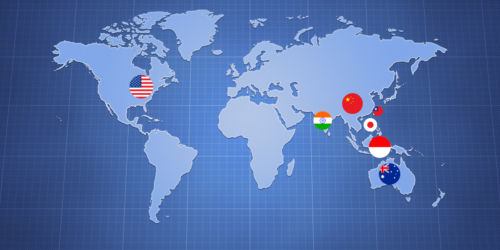
Essay
From Balancing to Coalition-Building: The US, Taiwan, and Asia’s Grand Reshuffling—Event in Review
A summary of the event, co-hosted by the Rajawali Foundation Institute of Asia and the Belfer Center for Science and International Affairs.
Q+A
President Biden hopes the passage of the CHIPS Act will jumpstart American microchip production. But as Jason Hsu explains, subsidies will only go so far in the global competition to gain dominance in the semiconductor industry.
Semiconductors, the building blocks of the modern information age, are critical components to seemingly every manufactured product from phones to cars to computers. The semiconductors and the microchips they supply have been at the forefront of policy debates of late, as global microchip shortages have shuttered assembly lines and contributed to product shortages around the world. With Taiwan, the global leader in semiconductor production, in the crosshairs of Beijing’s increasingly bellicose rhetoric, governments across Europe, Asia, and North America have been debating how to increase domestic production of microchips in response. To discuss the global microchip shortage, the challenge of building new domestic capacity, and the future of Taiwan’s dominance in the industry, we sat down with Jason Hsu, a senior research fellow at the Ash Center and a former member of Taiwan’s Legislative Yuan (national parliament) where he focused closely on technology policy, development, entrepreneurship and innovation.
Ash: What are the roots of the current microchip shortage and why have suppliers continued to struggle to meet global demand?
Jason Hsu: The current chip shortage is caused by several reasons. First of all, the COVID-19 pandemic created enormous demand for digital, telecommunication and electronic products— as more work was moved online or done remotely. The production of chips simply couldn’t meet the demand. Secondly, COVID-19 caused supply chain disruption. As the chip business is highly globalized and integrated, components, wafers and finished chips are backlogged in warehouses due to logistics disruption. Thirdly, the geopolitical risks have also exacerbated the shortage. For example, Russia’s invasion of Ukraine and continued U.S. export controls on sensitive technologies to China have all strained chip supplies.
How did Taiwan become the linchpin in global microchip production?
For the past three decades, Taiwan has been strategically developing the semiconductor industry as an important pillar of its national competitiveness strategy. Carrying out its industrial policy, which included investments in research and development — and recruiting U.S.-trained Taiwanese engineers and managers, Taiwan launched the Hsinchu Science Park in the 1980s, which ultimately developed into a powerhouse of chip manufacturing. Central to much of these efforts was Dr. Morris Chang, founding chairman of Taiwan Semiconductor Manufacturing Corporation (TSMC). Under Dr. Chang’s leadership, TSMC focuses relentlessly on the pursuit of engineering excellence and innovation in chip manufacturing. Today, Taiwan’s chip production accounts for 60% of the world’s total volume, and TSMC produces more than 90% of the leading-edge chips (defined as 7 nanometers and thinner). Hsinchu Science Park became a hub where up-and-down stream chip companies including those focused on design, manufacturing, equipment, testing and packing are tightly integrated.
President Biden is about to sign the CHIPS Act into law, which would pump an estimated $52 billion in subsidies intended to spur U.S. domestic microchip production. How did the U.S. ultimately cede its leadership in global microchip production to Taiwan?
In 1968 Robert Noyce and Gordon Moore created Intel and shortly thereafter launched the world’s first microprocessor, establishing a decade-long leadership position in the semiconductor industry. The U.S. continued to maintain its leading edge in microchip manufacturing until a little over 20 years ago — outperforming Japan and the rest of world. However, after 2000, the U.S. shifted its focus to design, innovation, research and development – with a concomitant reduction in capital spending and outsourcing of chip manufacturing overseas.
Semiconductor manufacturing requires a massive scale of investment and engineering input. As more and more U.S. chip companies turned fabless (outsourcing the physical manufacturing of chips), Taiwan chose to focus on the manufacturing process and built itself to become the global powerhouse of chip production. As Taiwan invests continuously in the improvement of advanced manufacturing technology, the U.S. has gradually lost its competitiveness as a result.
Do you think this legislation is sufficient to jumpstart U.S. domestic production to the levels required to meet the country’s demands for microchips? The question of subsidies asides, what other challenges does the U.S. face to building up its domestic microchip manufacturing industry?
The CHIPS Act, with its $52 billion in subsidies, is a good start in paving the ground for incentivizing chip manufacturers to bring back to production to U.S. soil. However, compared to industry spending overall, the federal subsidies are relatively small. The truth is money alone isn’t enough. There needs to be a comprehensive strategy that aims at creating long-term sustainability and overall industry integration that encompasses immigration policy, STEM education, tax benefit and research and development. The talent gap is the most severe challenge. Both Taiwan and U.S. face significant talent shortages in the semiconductor industry.
How does the CHIPS Act compare to efforts to support domestic microchip manufacturing in China and Europe?
China and Europe leverage state resources to heavily invest in chip manufacturing. Similar to U.S. efforts, the European Union introduced its own microchip manufacturing subsidy plan, which includes € 45 billion in public investments to attract chipmakers, STEM talent, and build new infrastructure. Through its national development program, China is investing over 10 trillion RMB (equivalent to $148.3 billion) over the next five years with the aim of reaching 70% self-sufficient capacity in microchip manufacturing by 2026.
What do the spiking tensions across the Taiwan Strait portend for the future of Taiwan’s semiconductor industry?
Given the geopolitical tensions, it’s not surprising that the semiconductor industry is viewed through the lens of national security. It is obvious that China has its eye set on Taiwan’s semiconductor industry. With the lack of advanced manufacturing technology and equipment, China is still at least 5 years behind Taiwan when it comes to chip manufacturing technology.
Even as tensions between the U.S. and China continue to escalate, I think it would be a mistake for policymakers to weaponize the issue of microchip production. A Chinese invasion of Taiwan would significantly disrupt the microchip supply chain, and the world economy will face irrevocable damage— as the impact of such a conflict would be all-encompassing. Moreover, most of Taiwan’s chipmakers have operations in mainland China.
A potential disruption in microchip manufacturing will hurt not only China but also the rest of the world. Taiwan and China are mutually dependent in terms of trade. In 2021 Taiwan’s trade surplus with China is 71.6 billion—of which 70% is semiconductor components. China needs Taiwan to sell the components needed to make semiconductors. U.S. chip companies also have business in China. To attack Taiwan with the secondary aim of gaining leadership over the global semiconductor industry would be an entirely self-defeating proposition for China. The damage that a military conflict would cause to the stability of the region, to say nothing of global economic impact, would be catastrophic.
Essay
A summary of the event, co-hosted by the Rajawali Foundation Institute of Asia and the Belfer Center for Science and International Affairs.
Feature
The Ash Center and Rajawali Foundation’s discussion on the Indo-Pacific focused on the evolving geopolitical dynamics between the U.S., China, and Taiwan, highlighting the complexity of Taiwan’s political identity and its strategic importance in regional security.
Video
As a new administration takes shape in Washington, join us for a timely discussion exploring the complex dynamics shaping the Indo-Pacific region. We will examine critical questions facing U.S.-Taiwan relations, regional security architecture, and economic partnerships across the Indo-Pacific. The discussion addressed key policy challenges including defense cooperation, trade relationships, and technological partnerships.
Essay
A summary of the event, co-hosted by the Rajawali Foundation Institute of Asia and the Belfer Center for Science and International Affairs.
Feature
The Ash Center and Rajawali Foundation’s discussion on the Indo-Pacific focused on the evolving geopolitical dynamics between the U.S., China, and Taiwan, highlighting the complexity of Taiwan’s political identity and its strategic importance in regional security.
Video
As a new administration takes shape in Washington, join us for a timely discussion exploring the complex dynamics shaping the Indo-Pacific region. We will examine critical questions facing U.S.-Taiwan relations, regional security architecture, and economic partnerships across the Indo-Pacific. The discussion addressed key policy challenges including defense cooperation, trade relationships, and technological partnerships.


